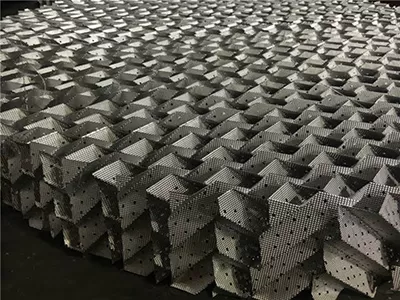Can Metal structured packing Be Cleaned?
Yes, metal structured packing can be cleaned effectively as part of routine maintenance to restore its performance and extend its service life. Its durability and chemical resistance make it compatible with various cleaning methods, ensuring that accumulated fouling, deposits, or contaminants can be removed without significant damage to the packing structure.

Metal structured packing, typically made from materials like stainless steel, aluminum alloys, or high-performance alloys (e.g., Hastelloy), is designed to withstand harsh industrial conditions, including the cleaning processes required to maintain its functionality. Over time, during operations such as distillation, absorption, or stripping, it may accumulate inorganic scale, organic residues, or particulate matter, which can reduce mass transfer efficiency and increase pressure drop. Cleaning addresses these issues by removing contaminants and restoring the packing’s original surface properties.
Common cleaning methods for metal structured packing include:
- High-pressure water rinsing: This method is effective for removing loose debris, light scale, or surface deposits. The high-pressure water jet penetrates the corrugated channels and dislodges contaminants without damaging the metal structure, making it suitable for regular maintenance or light fouling.
- Chemical cleaning: For more stubborn fouling, such as heavy scale or chemical residues, chemical cleaners are used. Acids (e.g., hydrochloric acid, citric acid) are effective for dissolving inorganic deposits like calcium or magnesium scale, while alkaline solutions or solvents may be used to remove organic fouling. The choice of chemical depends on the type of contaminant and the metal material, ensuring compatibility to avoid corrosion.
- Mechanical cleaning: In cases of severe fouling, mechanical methods such as brushing or scraping may be employed, often in combination with water or chemical rinsing. This is done carefully to avoid bending or damaging the thin metal sheets or corrugations.
Several considerations ensure safe and effective cleaning. First, the cleaning agent must be compatible with the metal type; for example, stainless steel can tolerate a wider range of chemicals than aluminum, which is more susceptible to corrosion from strong acids. Second, temperature and contact time during chemical cleaning should be controlled to maximize cleaning efficiency without causing material degradation. Finally, post-cleaning rinsing is essential to remove residual cleaning agents, preventing potential contamination of subsequent processes.
Regular cleaning of metal structured packing helps maintain consistent separation efficiency, reduces energy consumption, and minimizes the need for premature replacement. By selecting appropriate cleaning methods based on fouling type and metal material, operators can ensure that the packing continues to perform optimally in industrial separation processes.

